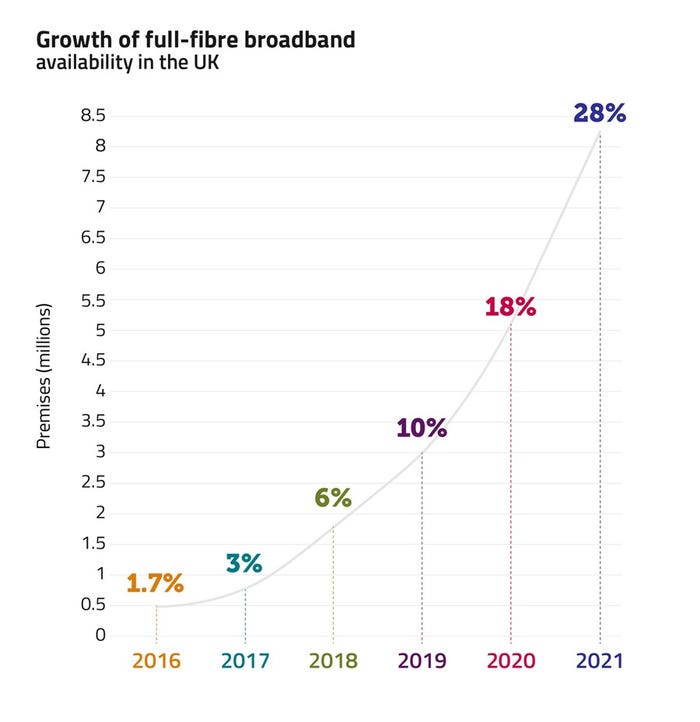Ofcom reckons around half of the UK population is now covered by 5G, sort ofOfcom reckons around half of the UK population is now covered by 5G, sort of
UK comms regulator Ofcom says the number of 5G base stations in the UK doubled in 2021, and coverage is now ‘outside 42-57 percent of premises.’
December 16, 2021

UK comms regulator Ofcom says the number of 5G base stations in the UK doubled in 2021, and coverage is now ‘outside 42-57 percent of premises.’
This was just one of a load of data points offered in its Connected Nations 2021 report. The broad stroke of the report implies roughly half the UK is now covered by at least one provider – though the phrasing was slightly grey.
The number of mobile base stations providing 5G services has more than doubled over the last year to over 6,500 sites across the UK – 87 percent of these are in England, 8 percent in Scotland, 3 percent in Wales and 2 percent Northern Ireland.
Ofcom went on to say: “EE, O2, Three and Vodafone first started rolling out 5G in 2019 and have continued to extend their networks across the UK. 5G is estimated to be available from at least one operator outside 42-57 percent of UK premises.”
There may well be good reasons for this specific wording, but it feels slightly like a slightly awkward caveat to include ‘outside premises’ when describing how much of the UK is covered by 5G connectivity.
Compare this to a statement by Ofcom’s German equivalent last week: “The Bundesnetzagentur’s data show that by the end of October 2021, over 53 percent of the country was already covered with the latest mobile communications standard, 5G, from at least one provider.”
A bullet point at the start of the press release states: ‘Around half of the properties in the UK are now in an area with outdoor 5G coverage’. This phrasing appears to be making allowance for the fact that, even if your house is near a 5G base station, it still might not get through your walls.
Describing roughly how many houses are covered by 5G networks seems to be a proxy for population coverage in this case – which would be a perfectly reasonable stat to communicate. Having said that, we would point out 5G at the consumer end is supposed to be a mobile technology.
The most useful information with regards to mobile network coverage is surely how much of the country you are likely to get signal as you travel around the place, not how many buildings are covered. Even those with access to 5G juice don’t really need it once they get home, due to the proliferation of high-speed broadband connections over wifi.
This was actually the point Ofcom put front and centre of its report – claiming more than 8 million homes can now get full-fibre broadband, which represents a 3 million increase over the last year.
“Many families now have multiple devices on the go at the same time for work, learning and entertainment – and the festive holidays can see a particular battle for bandwidth,” said Lindsey Fussell, Ofcom’s Network and Communications Group Director. “Full fibre is helping meet those demands, with millions more benefitting from faster speeds and more reliable connections. But some homes in hard-to-reach areas still struggle to get decent broadband, so there’s more work to do to make sure these communities get the connections they need.”
Inevitably the government followed up Ofcom’s release with a statement of its own: “Ofcom’s report shows we are making major progress on our commitment to deliver a digital infrastructure revolution,” said Digital Secretary Nadine Dorries.
“Superfast broadband, almost universally available thanks to our £2 billion investment, allows people to work remotely, video call and stream TV on multiple devices at once with no interruptions. But no one should miss out on better connectivity. Starting with areas still struggling with slow speeds, we are upgrading the nation with a further £5.5 billion of funding to close gaps in mobile coverage and deliver even faster gigabit broadband in rural areas.”
Celebrating the capabilities of ever more available fixed fibre home broadband is fine, but measuring mobile coverage in the same way – by how many homes are covered – doesn’t feel like the right tool for the job, especially when you’re talking about a technology that will often struggle to make it through wall.

Get the latest news straight to your inbox. Register for the Telecoms.com newsletter here.
About the Author
You May Also Like










.png?width=300&auto=webp&quality=80&disable=upscale)


_1.jpg?width=300&auto=webp&quality=80&disable=upscale)